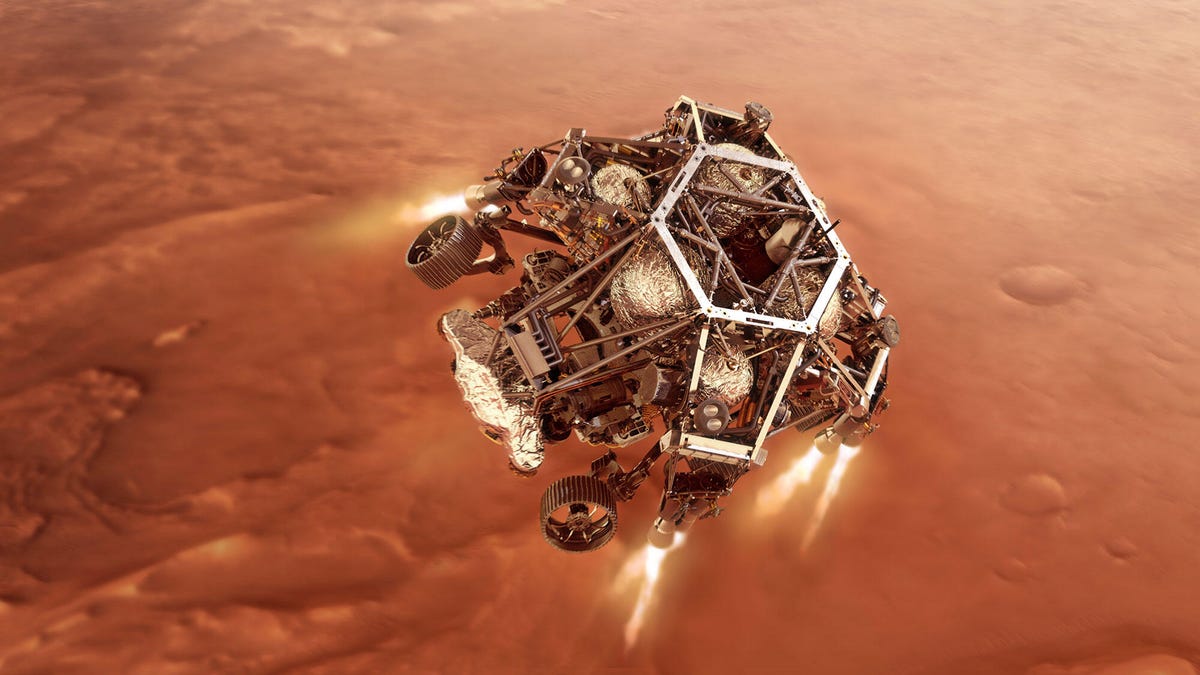NASA's Perseverance Mars rover landing will be thrilling must-see TV
When the next robot on Mars touches down on the red planet, the views will be truly otherworldly.

An illustration of Perseverance during its descent to the Martian surface.
NASA is about to land a shiny new robot on the surface of Mars, and for the first time, we'll be able to see and hear what it's like to touch down on another world. Perseverance is due to land in Jezero Crater on Thursday, becoming the first artificial object to land on the surface since the Mars Insight lander in 2018 and the first rover since Curiosity touched down in 2012.
But the new rover on the block is carrying more audio-visual gear than its predecessors to capture portions of the pivotal entry, descent and landing, or EDL, phase of the mission. A camera mounted on the back shell of the spacecraft is pointed up and will be able to catch a view of the parachutes that will deploy during descent to slow Perseverance as it comes in for its landing. Beneath this is a downward-pointing camera on the descent stage, which further slows and orients the rover for landing.
Finally, the rover itself is equipped with cameras and a microphone. Together, this suite of tech should provide us with the most detailed images and audio of a landing on Mars yet.
"We're going to be able to watch ourselves land for the first time on another planet," Lori Glaze, who heads the Planetary Science Division of NASA's Science Mission Directorate, told reporters during a briefing last month.
Perseverance carries its own audio-visual rigging.
The entire EDL phase will last only about seven minutes, but EDL lead Allen Chen calls it "the most critical and most dangerous part of the mission."
Perseverance will hit the Martian atmosphere traveling at almost 12,000 miles per hour (19,312 kilometers per hour), streaking across the sky as it begins to slow down. A 70-foot (21 meters) diameter parachute will deploy to slow it further. Afterward, its heat shield is released and radar is activated to help it determine its own location.
At an altitude of about one mile (1.5 kilometers), the descent module fires its engines and a new terrain relative navigation system, or TRN, kicks in to identify a safe landing spot. TRN is basically a sort of computer vision that allows the spacecraft to look at the terrain below and match it up with maps in its database.
The system slows down to a literal crawl, and then it's time for "sky crane," the same sort of hovering landing system the Curiosity rover used, which will allow Perseverance to basically lower itself softly to the surface.
This whole process will be fully automated without any input from mission control because of the delay in sending radio signals back and forth from Mars to the Earth.
Perseverance carries a number of science instruments to help look for signs of ancient life on our neighboring world, to collect samples that will be returned to Earth and to test some technologies for future Mars missions.
Also, it has a tiny helicopter.
Robots have spent years rolling around Mars, which is pretty cool, but for the first time NASA will use a small helicopter, dubbed Ingenuity, to try flying around the planet.
But before Ingenuity can fly, Perseverance has to nail its landing first. While its cameras and microphones will capture much of this whole process, there won't be a live feed like we've become accustomed to from the International Space Station or most launches from Earth. That's because the data relay Perseverance will be using during EDL is slower than even old dial-up connections.
However, after landing it will be able to use the Mars Reconnaissance Orbiter to send images back to Earth. Chen estimates that we'll be able to see at least some low-res images of the environment around Perseverance on the surface shortly after landing. We may have to wait a few days for more imagery and audio that paint the full picture of the landing process.
We will, however, have live feeds from mission control, which provided some of the more iconic images from the Curiosity landing. (Mohawk guy, anyone?) Of course, COVID-19 protocols will be in effect at mission control, but it's unlikely that even the pandemic will dampen the celebration of a successful landing.
"I don't think that COVID is going to be able to stop us from jumping up and down and fist bumping," said Deputy Project Manager Matt Wallace. "You're going to see a lot of happy people no matter what, once we get this thing on the surface safely."
Follow CNET's 2021 Space Calendar to stay up to date with all the latest space news this year. You can even add it to your own Google Calendar.

